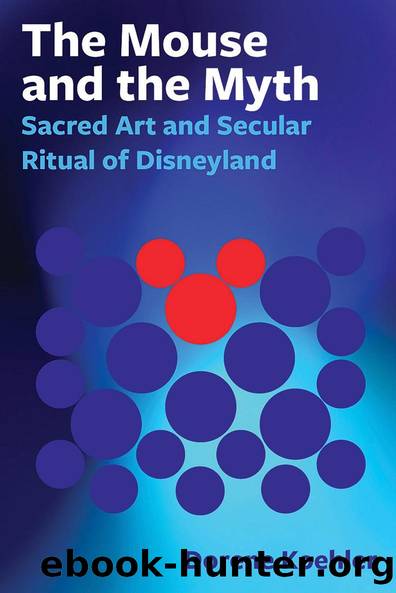The Mouse and the Myth by Dorene Koehler

Author:Dorene Koehler [Koehler, Dorene]
Language: eng
Format: epub
Tags: Social Science, Folklore & Mythology, Popular Culture, Psychology, Movements, Jungian, Media Studies
ISBN: 9780861969326
Google: Y1SmDgAAQBAJ
Publisher: Indiana University Press
Published: 2017-04-24T03:29:09+00:00
Chapter 5
Spectacular Spectacle
Communitas is often speculative and generates imagery and philosophical ideas. â Victor Turner211
⦠by its very nature sacred time is reversible in the sense that, properly speaking, it is a primordial mythic time made present. â Mircea Eliade212
The Crafted Communitas of Disneyland
Imagine: You stand in front of the castle in a throng of people. You canât contain your excitement, but thatâs OK because neither can anyone else around you. They cheer, and you jump to your feet. You watch in animated exhilaration as you wait for the fireworks to begin. Youâve been there for hours. Your legs ache. You feel the push of the crowd around you, but still you wait. You want to sit, but when you do others come in to stand in front of you. You become frustrated, so you stand and wait. A voice comes over the sound system reminding you that in just 30 minutes, 15 minutes, just a minute the fireworks will begin. The light dims and the crowd cheers. The anticipation is palpable. Itâs one of the major âshows within the showâ. This is the space where liminality meets communitas.
David Mamet wrote that dramatic structure is âan exercise in a naturally occurring need or disposition to structure the world as thesis/antithesis/synthesisâ.213 He invokes Hegel and the rhetorical tradition of dialectics in order to suggest that drama, if it is to work, must present points of plot before it finishes with some kind of a flourish, a conflagration of themes and messages. He suggests that synthesis is inherent to drama, though also problematic, full of conflicting images, ideas, and feelings. The syncretic nature of drama is one of the central connections between it and ritual. Drama becomes mythic ritual through the energy it creates for the crowd, energy created for the dual experience of liminality and communitas.
Grounding his theories in the context of a Durkheimian214 style analysis of ritual and culture, Victor Turner circles around a similar idea: an authentic experience of religious imagination generally requires fellowship, and this fellowship creates its own energy, its own mythic reality. Disneyland partakes in the ritual tradition suggested by Mamet, Turner, and Durkheim through its participation with the characteristics of ritualized temple culture. It allows those present in the park to come together in a genuine practice of community. One might argue that the entire experience of the theme park is an experience of ritual fellowship,215 and indeed in many ways this is true. The entire park itself is a spectacle, as I suggested when I argued that Disneyland is a temple fashioned through the spectacle media of stage and screen. From a phenomenological point of view, engaging with spectacle peppers the patronâs entire encounter with a place, beginning with the disembodied voice that announces events to the crowd over the loud speaker and continuing with theater attractions such as Great Moments With Mr. Lincoln, and Walt Disneyâs Enchanted Tiki Room, as well as âgone, but not forgottenâ attractions such as America Sings and the Country Bear Jamboree.
Download
This site does not store any files on its server. We only index and link to content provided by other sites. Please contact the content providers to delete copyright contents if any and email us, we'll remove relevant links or contents immediately.
The Social Psychology of Inequality by Unknown(2987)
Make Comics Like the Pros by Greg Pak(2883)
Stacked Decks by The Rotenberg Collection(2843)
Purple Hibiscus by Chimamanda Ngozi Adichie(2738)
The Queen of Nothing by Holly Black(2541)
The Art of Doom by Bethesda(2130)
Life of Elizabeth I by Alison Weir(2051)
Putin's Labyrinth(1986)
The Power of Habit: Why We Do What We Do in Life and Business by Charles Duhigg(1970)
Drawing Down the Moon by Margot Adler(1842)
Things Are What You Make of Them: Life Advice for Creatives by Adam J. Kurtz(1835)
Agency by William Gibson(1800)
Wall and Piece by Banksy(1797)
Art Of Atari by Tim Lapetino(1770)
Teaching to Transgress: Education as the Practice of Freedom (Harvest in Translation) by Bell Hooks(1738)
The Beatles Lyrics by Hunter Davies(1694)
The Pin-Up Art of Bill Ward by Bill Ward(1674)
Only What's Necessary: Charles M. Schulz and the Art of Peanuts by Chip Kidd(1667)
The Andy Warhol Diaries by Andy Warhol(1576)
